
Mineral Insulated (MI)
series heating systems
INSTALLATION, MAINTENANCE AND
OPERATION MANUAL

2 | nVent.com/RAYCHEM
1
2
3
4
5
6
7
8
9
10
11
General information 4
Heating cable selection and storage 7
Heating cable installation 9
Components selection and installation 23
Temperature control and limitation 24
Thermal insulation and marking 27
Power supply and electrical protection 31
System testing 32
Operation, maintenance and repairs
33
Trouble Shooting
35
Installation Record Sheet
36

nVent.com/RAYCHEM | 3
Typical configuration for MI-heating cable system
(single conductor)
Typical configuration for MI-heating cable system
(dual conductor)
Junction box
MI cold lead cable (single conductor)
Circuit identification tag
Hot/cold joint
MI cold lead cable (dual conductor)
Hot/cold joint
Circuit identification tag
Junction box
Dual conductor
MI heating cable
End cap
Loop of MI heating cable
(single conductor)

4 | nVent.com/RAYCHEM
1 GENERAL INFORMATION
Use of the manual
This Installation and Maintenance manual applies to nVent RAYCHEM Mineral
Insulated (MI) series resistance heating cable systems installed on thermally
insulated pipes and vessels and associated equipment. In particular it refers to
mineral insulated (MI) series heating systems, which feature a specific power
output depending on various design parameters, in particular, cable length and
voltage. This manual provides general information and shows an overview
of the most common installations and applications on MI as well as typical
examples. In any case the information provided for specific projects will take
precedence over this manual. In case of conflicts, please contact your nVent
representative.
nVent offers two different cable constructions for electrical heat-tracing
purposes: single conductor cables, which are typically laid in loop
configurations and dual conductor cables, which are typically laid in single
runs.
Figure 1: Typical cable construction
Various types of the MI bulk heating cables are available:
HCC/HCH: Copper sheathed MI heating cables
HDF/HDC: Cupro-nickel sheathed MI heating cables
HSQ: Stainless steel sheathed MI heating cables
HAx: Alloy 825 sheathed MI heating cables
HIQ: Inconel sheathed MI heating cables
Figure 2: Typical heating unit designs
Design type B
Single conductor
Heating
conductor(s)
Insulation
(magnesium oxide)
Single-conductor cable
Dual-conductor cable
Metal sheath
Metal sheath
Potted seal
Heating cable length
Hot/cold joint
Cold lead cable
(standard 1.2 m)
300 mm
Flexible
tail length
Gland

nVent.com/RAYCHEM | 5
Design type D
Dual conductor
Design type E
Dual conductor
The joints can be either brazed or laser welded, refer to
nVent RAYCHEM product literature for more detailed information.
Please note that this manual only covers the installation of pre-
fabricated MI heating units. The complete termination process and
repair of heating cable units is not covered by this manual and must be
carried out by qualified and experienced personnel only. Keep ends of
heating cables and kit components dry before and during installation.
For more information contact your nVent representative.
Important
For the nVent warranty to apply, the instructions of this
manual must be followed. Design, installation, inspection,
operation and maintenance must be in accordance with the
standards IEC EN 60079-0, IEC EN 60079-30-1 and IEC EN 60079-31
(where applicable). Other local requirements and national electric codes
applicable to electrical heat-tracing systems must be followed as well.
Personnel involved in the installation, testing and maintenance of electric
heat-tracing systems must be suitably trained in all special techniques
required, as well as in general electrical installation work. All work should
be monitored by supervisors experienced in heat-tracing applications.
The presence of the heating cables shall be made evident by the posting
of caution signs or markings at appropriate locations and/or at frequent
intervals along the circuit
300 mm
Flexible
tail length
Potted seal
Heating cable length
Hot/cold joint
Gland
End cap
Cold lead cable
(standard 1.2 m)
300 mm
Flexible
tail length
Potted seal
Heating cable length
Hot/cold joint
Gland
Cold lead cable
(standard 1.2 m)

6 | nVent.com/RAYCHEM
Area Classification – Ordinary
HCC/HCH/ HDC/HDF/HSQ/HAx/HIQ
Area Classification – Hazardous, Zone 1 or Zone 2 for
gas / Zone 21 or Zone 22 for dust
Specific conditions of use in hazardous area:
1. The MI Cable Seal assembly is to be installed within a suitable
enclosure to protect from light and impact
2. The MI Cable Seal Assembly has a service temperature range of
–30°C to +120°C or –30°C to +105°C or –60°C to +70°C. See the
manufacturer’s instructions for further information.
3. The maximum withstand temperatures & supply voltages are shown
table 1 “Properties of MI heating units”
4. The minimum installation temperature is –60°C
5. The minimum cable spacing must not be less than 25mm.
6. The minimum bending radius is 6 x cable diameter
7.
Extreme care shall be used when handling and manipulating the
Mineral Insulated Electric Heating cables. Repeated bending actions
of the cable may weaken the mechanical strength of the cable which
could lead to failure. For further information, consult the manufacturer.
8. Consideration shall be given during the selection of the heating
cable sheath material for the environmental exposure. Certain
environmental impurities may lead to failures such as stress
corrosion cracking (SCC). Consult the manufacturer for further
information.
9. When PVC sleeving is used the operating temperature must not
exceed +85°C.
10.
When used in dust atmospheres the Compression Ring Type cable Gland
shall be sealed in accordance with the manufacturer’s instructions and
applicable code of practice, and the enclosure to which the gland is
attached shall be provided with a minimum ingress protection of IP6X.
11. The heating element supply circuit must include an electrical
protection device in accordance with EN 60079-30-1
Certificate No. Code Nos.
HCC/HCH/HDC/HDF/HSQ/HAx/HIQ (Heating units)
Baseefa 13ATEX0174X
II 2 G Ex 60079-30-1 db eb IIC T* Gb
II 2 D Ex 60079-30-1 tb IIIC T*˚C Db IP6X
(for * see schedule)
IECEx BAS 13.0090X Ex 60079-30-1 db eb IIC T* Gb
Ex 60079-30-1 tb IIIC T*˚C Db IP6X
(for * see schedule)
HCC/HCH/ HDC/HDF/HSQ/HAx/HIQ (bulk cable)
Baseefa 13ATEX0173U
II 2 G Ex 60079-30-1 IIC Gb
II 2 D Ex 60079-30-1 IIIC Db
IECEx BAS 13.0091U Ex 60079-30-1 IIC Gb
Ex 60079-30-1 IIIC Db
№ ЕАЭС RU С-ВЕ.МЮ62.В.00879/19
ООО «ПРОММАШ ТЕСТ»
Ambient temp range: -60°C...+70°C
1Ex e IIC T* Gb X
Ex tb IIIC T* Db X
*: by design
Units made in Canada, Germany or Poland.
Bulk cable made in Canada or Italy

nVent.com/RAYCHEM | 7
The order reference of MI heating units uses
the following nomenclature
When ordering, the complete order reference of the MI heating unit needs
to be provided. For hazardous areas, information must also be provided
about the T-rating and temperature data relevant to the application (max.
sheath temperature data) to enable the correct representation of data on
hazardous area tags attached to the completed heating unit in the factory.
Before installation, check the suitability of the heating units supplied.
Changes to any of the parameters may require a re-design and must be
confirmed before installation.
2 HEATING CABLE SELECTION AND
STORAGE
The selection of the proper heating cable and components, best suited for
the application must be checked against the relevant product literature,
the most important product properties are summarized in following table:
Table 1: Properties of MI heating units
Please check against individual datasheet or contact
B/HSQ1M1000/43.0M/1217/230/1.2M/S33A/X/NPM25/EX
Area classification:
EX, ORD
Gland size NPM25 (Nickel
plated brass), SSM25
(stainless steel) etc
Hot/cold joint material type:
X -stainless steel, Y - brass,
LW - laser welded
Cold lead rating and sheath type
Cold lead length: M for unit in meters
(standard is 1.2 m)
Heating unit: Operating voltage
Heating unit: total wattage in W
Unit length: M for unit in meters
Heating cable reference
Heating cable unit type: Type B, D or E
MI Heating Cable Type HCC/ HCH HDC/ HDF HSQ
Number of conductors 1 1 1
Maximum voltage (U0/U) 300 / 500 V
Maximum withstand temp.
(1)
Brazed heating unit 200°C 400°C 550°C
Laser welded heating unit – –
680°C
Temperatureclassification T6 – T3 T6 – T2 T6 – T1
Minimum cable spacing 25 mm
Minimum installation temp. –60°C
Minimum bending radius 6 x Cable Diameter
Chemical resistance Low Medium Medium

8 | nVent.com/RAYCHEM
The maximum cable power output is directly dependant on the application
and control method used. The actual limits of MI heating cables in a
specific application are given in Raychem Engineering Software us (e.g.
TraceCalc Pro design software). For more details, please contact us.
Ensure that the heating cable voltage and temperature rating is suitable
for the application.
Changing design parameters such as voltage or cable length will result
in a different power output and maximum sheath temperature. This may
require a redesign of the entire system.
To prevent fire or explosion in hazardous areas, verify that the
maximum sheath temperature of the heating cable is below T-class
or auto-ignition temperature of the gases present in those areas. For
further information, see design documentation (e.g. TraceCalc Pro
reports).
For the evaluation of the chemical resistance of MI heating cables (for
corrosion aspects), refer to our product datasheets or contact nVent
for assistance. Check the design specification to make sure the correct
heating cable is installed on each pipe or vessel.
Refer to nVent RAYCHEM product literature to select an appropriate
heating cable for each thermal, chemical, electrical and mechanical
environment.
Storage and transportation
Store and transport MI heating units in a clean, dry place or
container.
Protect the heating cable from moisture and mechanical damage.
Storage below 10°C may result in surface condensation, potentially
causing low insulation resistance.
After extended storage, it is strongly recommended to measure the
insulation resistance of MI heating units prior to installation, also
refer to section 8.
MI Heating Cable Type HAx1N HAx2N HAx2M HIQ
Number of conductors 1 2 2 1
Maximum voltage (U0/U) 600/600 V 300/300
V
300/500
V
Maximum withstand temp.(1)
Brazed heating unit 550°C 550°C 550°C 550°C
Laser welded heating unit 680°C 680°C 680°C 680°C
Temperature classification T6 – T1 T6 – T1 T6 – T1 T6 – T1
Minimum cable spacing 25 mm
Minimum installation temp. –60°C
Minimum bending radius 6 x Cable Diameter
Chemical resistance High High High High
Contact nVent for further details
(1)
The hot-cold junction used in a heating unit may lead to temperature
limits below the limit of the heating cable. Contact nVent if the
exposure temperature exceed values given in the tables above for
more detailed instructions how the unit can be installed under those
circumstances.

nVent.com/RAYCHEM | 9
3 HEATING CABLE INSTALLATION
Warning
As with any electrical equipment or wiring installation that operates at
line voltages, damage to heating cable and components, or incorrect
installation that allows the penetration of moisture or contamination
can lead to electrical tracking, arcing and potential fire hazard. In case
of damage and later repair on site any unconnected heating cable end,
exposed to the environment, must be sealed appropriately.
3.1 Pre-installation checks
Check design recommendations:
Verify that you have all required engineering documents supporting
the installation
Check for any special instructions in engineering documentation
(e.g. cover with aluminium foil, use of metal mesh, fixation etc...).
Verify that hazardous area information given in engineering
documentation is compatible with the area classification the
material will be installed in.
Check materials received:
Inspect heating cable and components for in-transit
damage.
Review the heating cable design and compare the list of designed
materials to the catalogue numbers of heating cables and
electrical components received to confirm that proper materials
have been received on site. The heating cable type and hazardous
area marking (if applicable) is printed on a tag label supplied with
each heating element.
Measure and note down the electrical resistance and the insulation
resistance of the cable. Compare these values to those in the
design documents (see section 8).
Check equipment to be traced:
Check identification, length and diameter of pipework/
vessel against the design documents. Also verify, that actual
temperatures and insulation properties are in alignment with the
design documentation.
Ensure all pressure testing of pipework/ vessel is complete and
final paint and pipe coatings are dry to touch.
Walk the system and plan the routing of the heating cable on the
pipe, including tracing of heat sinks. e.g. valves, flanges, supports,
drains etc.
Inspect piping for burrs, rough surfaces, sharp edges
etc. which could damage the heating cable. Smooth off

10 | nVent.com/RAYCHEM
or cover with layers of aluminium foil. At elevated sheath
temperatures consider the use of stainless steel foil.
(e.g. HSQ; HIQ or HAx).
Surface areas where heat-tracing is to be installed must be
reasonably clean. Remove dirt, rust and scale with a wire brush
and oil and grease films with a suitable solvent.
3.2 Heating cable pulling and laying and General
Installation Guidelines
Heating cable pulling tips:
Figure 3: Importance of cable pulling direction
Avoid distortion of the cable and kinking.
When pulling the heating cable, avoid:
Sharp edges
Excessive pulling force
Kinking and crushing
Running over it with equipment.
Pulling into a spiral
Avoid pulling the cable by the flexible pig tail wires of the cold
lead(s).
The minimum bending radius of the heating cable must be respected.

nVent.com/RAYCHEM | 11
Figure 4 : Minimum bending radius of MI heating cables
Do not repeatedly bend and straighten the cable.
Keep heating cable strung loosely but close to the pipe being
traced, to avoid interference with supports and other equipment.
Add additional heating cable to trace the fittings and supports as
required by the design specification or engineering documents.
Leave the appropriate amount of heating cable at all power
connection, splice and tee locations.
Do not bend the cable within 150 mm of the hot to cold junction
or remote terminations.
Do not bend the cold lead within 150mm of the termination pot
seal.
Avoid crushing and excessive bending or pulling of cold leads
during installation, testing and commissioning
To maintain the integrity of the epoxy seal termination, avoid the
application of excessive heat to the epoxy during installation,
commissioning and operation of the heating units
Keep gland back nut and olive assembled to the body to reduce
chance of impact damage during installation.
To prevent galling of threads when using stainless glands, a thread
lubricant should be applied to the male thread mating with the
female backnut.
When installing MI and other constant wattage heating cables,
ensure that they do not overlap or cross. Doing so may lead to
local over-heating and hazard of fire.
Figure 5 : Minimal spacing must be respected
6 x ∅

12 | nVent.com/RAYCHEM
Minimum cable spacing: 25 mm (lower spacings may be possible
but require special attention and must be properly documented in the
engineering documentation).
For installation in hazardous areas, the standard minimum spacing is
50 mm. This must be respected, unless lower spacings are specifically
allowed in the engineering documentation.
Heating cable allowances
All parts of a heat traced system which increase the surface area of the
normally insulated pipe/ vessel (e.g. valves or flanges) or metallic fins that
protrude out of the insulation (e.g. supports), will increase the overall heat
loss. These areas of increased heat loss require compensation, either by
using higher overall design safety factors or by the addition of extra cable
length. The heating cable allowances are specified in design software and
documentation.
For some applications, it may be physically impossible to install all of the
recommended heating cable directly on the fitting or support. In this case,
install the excess heating cable on the pipe, on either side of the fitting or
support, or distribute the additional heater length along the entire circuit
length if a lower local temperature is acceptable. This constraint may be
difficult for small pipes and/or multiple cable runs. If required, contact
nVent for assistance.

nVent.com/RAYCHEM | 13
3.3 Heating cable attachment
Fix in place with metal bandings, tie wire or wire cloth band at a
typical interval of 300 mm and additionally where necessary.
The use of tie wire with softer sheath MI heating cables (like
copper HC and cupro-nickel HD) should be avoided, as the tie
wire can damage the heating cable surface over time. Do not
overtighten tie wire, use wire cloth band wherever possible.
The hot to cold junction should be secured with metal bands at a
typical distance of 150 mm on either side of the joints.
Cable must be installed and fixed such that movement of cable
during its heating up cycles is permitted, but not to allow cable
to move freely under its own weight. Other attachments (like
aluminium tape or glass tape) may be used, if specified in the
design documentation.
The heating cables may be installed in straight, multiple runs as
required by the design specification.
On horizontal pipes fix on lower quadrant as shown below and not
on bottom of pipe.
Figure 6 : Cable orientation on pipe
On vertical pipe sections fix the heating cables equally distributed
around the pipe circumference.
Read the design documents, in particular concerning the need
for cable allowances and regard the location of junction boxes/
controllers before permanently attaching the cable to the pipe.
Weatherproof
jacket
Insulation
Cable
Pipe
One heating cable
Cable
Cable Cable
Cable
Two heating cables
Cable
Temperature
sensor
Temperature
sensor
Temperature
Sensor

14 | nVent.com/RAYCHEM
Verify if the design documentation requires that the heating cables
have to be covered by aluminium or stainless steel foil before the
insulation is applied.
Installation on tanks typically requires additional fixing devices as
pre-punched steel strips as shown below:
Figure 7: Typical cable layout on large surfaces like tank walls
Figure 8: Fixing device: pre-punched metal strap
Avoid sharp edges and properly seal penetration of MI cold lead
cables through the insulation cladding.
Cold
leads
Junction
box
Temperature
controller
Heating cable
Temperature
sensor
Banding
Prepunched
strapping

nVent.com/RAYCHEM | 15
3.4 Attachment materials
Stainless steel pipe straps for different pipe dimensions up to 36 “
(e.g. PB 300).
Stainless steel banding (30 m roll) together with stainless steel
buckles (one per fixing) (e.g. SNLS + SNLK).
Tie wire (e.g. RMI-TW) is especially suitable for the fixation on
irregular shapes like pumps, valves etc.. The use of tie wire with
softer sheath MI heating cables (like copper HC and cupro-nickel
HD) should be avoided where possible, as the tie wire can damage
the heating cable surface over time, use wire cloth band wherever
possible. For the installation of MI heating cables on metal
meshes, tie wire may be used, but must not be overtightened
and should allow for free movement of MI heating cable during
expansion and contraction.
Pre-punched metal banding allowing fixed heater spacing, where
multiple runs of cable are applied
(e.g. HARD-SPACER-SS-25MM-25M).
Various types of metal meshes are available for installation on
tanks, valves, pumps (e.g. mesh types FT-19 and FT-20)
3.5 Typical installation details
The following details show some principles of MI cable installation,
using dual conductor cables. Single conductor cables follow the same
principles, but typically form a loop. Attention must be given, for single
conductor configurations, where both ends need to be terminated in the
same power supply box.
Where feasible, uncoil the heating cable and lay it alongside the
pipe section to be traced. For shorter single conductor cable, to
be installed in the form of a „hairpin“, it may be advantageous to
unroll the heating cable, loop it, and then lay it alongside the pipe
section so that both runs of cable can be installed simultaneously.
Figure 9: Uncoiling heating cable
Figure 10: Attaching hot-cold joint and end cap
End
cap
Hot-cold joint
Tie wire /
wire cloth band
Stainless steel pipe strap, banding,
tie wire, wire cloth band, etc.
Leave large
bending radius (typ.)
End
cap
End
cap
Hot-cold joint
Tie wire /
wire cloth band
Stainless steel pipe strap, banding,
tie wire, wire cloth band, etc.
Leave large
bending radius (typ.)
End
cap

16 | nVent.com/RAYCHEM
Attach hot-cold joint to end of pipe nearest the power supply point,
and the other end of heating cable to the other end of the pipe.
Support hot-cold joint by attaching cable with pipe straps/banding
at a distance of 6 inches (150 mm) on either side of joint. Secure
joint itself to pipe with a pipe strap/band as shown in Figure 10.
Fasten middle of heating cable to the halfway point of pipe leaving
equal slack on either side.
Attach heating cables to pipe with pipe straps/banding,
tie wire or wire cloth band at 12-18 inches (300-450 mm) intervals.
Tie wire should be snug, but should not cut or indent the sheath.
The use of tie wire with softer sheath MI heating cables (like
copper HC and cupro-nickel HD) should be avoided, as the tie
wire can damage the heating cable surface over time, use wire
cloth band wherever possible.
Figure 11: Allowances for valves, flanges, and pipe supports
Use tie wire or wire cloth band to hold cable to irregularly shaped
objects such as valves or pipe supports.
Figure 12: Installing cable on valves and pipe supports
Allow cable to wave along pipe as per Figure 14 und 15. This
allows for expansion and contraction of the heating cable as it
heats up and cools down. The recommended field variance to
allow for a wave is about 2% of the total length. Use up excess
cable by waving along pipe and increasing amount used at each
pipe support.
Note: Do not use up excess cable at one location.
Distribute equally along pipe.
End
cap
Hot-cold joint
Tie wire /
wire cloth band
Stainless steel pipe strap, banding,
tie wire, wire cloth band, etc.
Leave large
bending radius (typ.)
End
cap
End
cap
Hot-cold joint
Tie wire /
wire cloth band
Stainless steel pipe strap, banding,
tie wire, wire cloth band, etc.
Leave large
bending radius (typ.)
End
cap

nVent.com/RAYCHEM | 17
Figure 13: Completed MI heating cable installation
Figure 14: Pipe strap spacing
Figure 15: Fastening several runs of cable
Note: Where several heating cables are required, a
pre-punched metal strapping may aid the installation and
consistent spacing of heating cables.
End
cap
Hot-cold joint
Tie wire /
wire cloth band
Stainless steel pipe strap, banding,
tie wire, wire cloth band, etc.
Leave large
bending radius (typ.)
End
cap
Stainless steel pipe straps, banding,
or tie wire, wire cloth band, etc...
Drip loop
Cold
lead
Hot-cold
joint
Cold
lead
Junction box
150 mm
Insulation
app. 300 mm
150 mm
app.
300 mm
Use wide stainless banding
(tension with hand-tensioner only)
Prepunched metal strapping
Wave cables with a minimum spacing of 25 mm
to 50 mm along pipe, unless design documentation
clearly states other values.

18 | nVent.com/RAYCHEM
Figure 16a: Valves
For valve sizes 3
1
/
2
“ (90 mm) or smaller
Figure 16b: Valves
For valve sizes larger than 3
1
/
2
“ (90 mm)
The minimum spacing must be respected, unless design
documentation clearly states other values, also refer to page 11,
figure 5.
Pipe
Valve body
Apply tie wire or
wire cloth band to
hold MI heating
cable in place.
MI
heating
cable
MI heating cable
See design drawing
for specific heating
cable length needed.
Stainless steel pipe straps,
banding, tie wire or wire cloth band
Pipe
Valve body
MI heating cable
See design drawing
for specific heating
cable length needed.
MI
heating
cable
Apply tie wire,
wire cloth
band or other
appropriate
fixing material to
hold MI heating
cable in place.
Stainless steel pipe straps,
banding, tie wire/wire cloth band
Pipe
Valve body
Apply tie wire or
wire cloth band to
hold MI heating
cable in place.
MI
heating
cable
MI heating cable
See design drawing
for specific heating
cable length needed.
Stainless steel pipe straps,
banding, tie wire or wire cloth band
Pipe
Valve body
MI heating cable
See design drawing
for specific heating
cable length needed.
MI
heating
cable
Apply tie wire,
wire cloth
band or other
appropriate
fixing material to
hold MI heating
cable in place.
Stainless steel pipe straps,
banding, tie wire/wire cloth band

nVent.com/RAYCHEM | 19
Figure 17: Installation at 90° elbow
Figure 18: Flanges
Steel pipe
Stainless steel pipe straps,
banding, tie wire or
wire cloth band(typical)
MI heating cable
MI heating cable is applied to
outside radius of elbow.
Flange
3" (8cm) max from strap
to edge of flange
Heating cable
Apply stainless
steel tie wire to
hold heating
cable in place.
Notes:
1. Heating cable must maintain contact
with flange when bending the cable
around the pipe flanges.
2. In hazardous areas, secure the cable to
the pipe on either side of the flange
using pipe straps.
Stainless steel
pipe straps,
banding, or
tie wire

20 | nVent.com/RAYCHEM
Figure 19: Cable layout over clamps and straps
Figure 20 : Shoe and sleeve type support
The minimum spacing must be respected, unless design
documentation clearly states other values, also refer to page 11,
figure 5.
Figure 21: Dummy supports
Insulation
Dummy leg
Pipe
shoe
Heating
cable
Stainless steel pipe straps,
banding, tie wire or wire
cloth band
Stainless steel pipe straps,
banding, tie wire or wire
cloth band (typical)
See design drawings for specific
heating cable length needed.
MI heating cable
Pipe
MI heating
cable
Stainless steel pipe straps,
banding, or tie wire
Pipe
Bar hanger
3” (8 cm)
maximum
Notes: In hazardous areas, secure the cable to the pipe on
either side of the pipe support using pipe straps
Page is loading ...
Page is loading ...
Page is loading ...
Page is loading ...
Page is loading ...
Page is loading ...
Page is loading ...
Page is loading ...
Page is loading ...
Page is loading ...
Page is loading ...
Page is loading ...
Page is loading ...
Page is loading ...
Page is loading ...
Page is loading ...
Page is loading ...
Page is loading ...
Page is loading ...
Page is loading ...
Page is loading ...
Page is loading ...
Page is loading ...
Page is loading ...
-
 1
1
-
 2
2
-
 3
3
-
 4
4
-
 5
5
-
 6
6
-
 7
7
-
 8
8
-
 9
9
-
 10
10
-
 11
11
-
 12
12
-
 13
13
-
 14
14
-
 15
15
-
 16
16
-
 17
17
-
 18
18
-
 19
19
-
 20
20
-
 21
21
-
 22
22
-
 23
23
-
 24
24
-
 25
25
-
 26
26
-
 27
27
-
 28
28
-
 29
29
-
 30
30
-
 31
31
-
 32
32
-
 33
33
-
 34
34
-
 35
35
-
 36
36
-
 37
37
-
 38
38
-
 39
39
-
 40
40
-
 41
41
-
 42
42
-
 43
43
-
 44
44
Raychem кабеля с минеральной изоляцией Installation guide
- Type
- Installation guide
- This manual is also suitable for
Ask a question and I''ll find the answer in the document
Finding information in a document is now easier with AI
Related papers
-
Raychem MI-serie Installation guide
-
Raychem konstant wattstyrke Installation guide
-
Raychem Elexant 450c Installation guide
-
Raychem Leak Detection Installation guide
-
Raychem MI Industrial Heat-Tracing Installation guide
-
Raychem Réparation de câbles à isolant minéral Installation guide
-
Raychem Industrial Heat-Tracing Installation guide
-
Raychem MI Installation guide
-
Raychem MI Surface Snow Melting Installation guide
-
Raychem PI-kablar Installation guide
Other documents
-
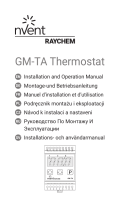 nvent GM-TA Thermostat User manual
nvent GM-TA Thermostat User manual
-
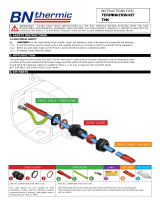 BN Thermic THK Operating instructions
BN Thermic THK Operating instructions
-
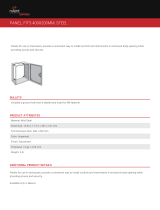 nVent Hoffman Panel fits 400x200mm Steel User guide
nVent Hoffman Panel fits 400x200mm Steel User guide
-
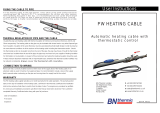 BN Thermic PW Operating instructions
BN Thermic PW Operating instructions
-
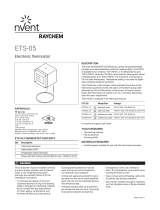 nvent ETS-05 Serial User manual
nvent ETS-05 Serial User manual
-
nVent RAYCHEM AT-TS-13 User manual
-
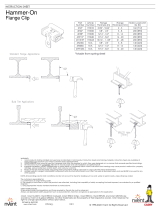 nVent CADDY 2H4 Hammer-On Flange Clip Operating instructions
nVent CADDY 2H4 Hammer-On Flange Clip Operating instructions
-
nVent Hoffman Cleantray 90-Degree Elbow Top Cover Sloped Inward Operating instructions
-
EasyHeat SR, TSR, HSR and HW Series Heating Cables, 14030-001 Owner's manual
-
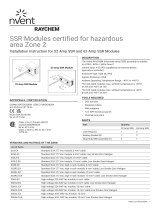 nVent RAYCHEM SS3-EX SSR Modules Certified for Hazardous Area Zone 2 Operating instructions
nVent RAYCHEM SS3-EX SSR Modules Certified for Hazardous Area Zone 2 Operating instructions


















































